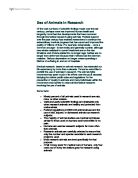Some facts:
- Ninety percent of all animals used in research are rats, mice, or other rodents.
- Valid and useful scientific findings are obtainable only when research animals are healthy and protected from undue stress.
- Federal regulations prohibit both animal abuse and the use of sick, injured, or distressed animals as research subjects.
- The majority of animal studies use medical techniques similar to those used on humans and involve little or no pain.
- Humans are used as research subjects far more often than animals.
- Research animals are carefully selected to ensure that only the number and species essential to each research project is used.
- Most research animals are bred specifically for that purpose.
- Of all money spent for medical care of humans, only four cents out of every ten dollars goes for research using animals
Because medical researchers rely heavily on computers for many purposes in their scientific studies, some people assume that computers can - or someday will - replace the use laboratory animals. However, computer operations depend entirely on the quality and amount of data entered in the machine to begin with, as well as the accuracy of the computer program designed to process those data. In order to model living systems and their intricate interactions within the computer, the needed data must first be gathered from studies in living animals.
Federal Legislative History
Animal use in research has become heavily regulated by the federal government over the past thirty years. In 1963, The National Institutes of Health published the first Guide for Laboratory Animal Facilities and Care for the purpose of assisting institutions in caring for and using laboratory animals in ways judged to be professionally and humanely appropriate. Public Law 89-544, The Animal Welfare Act, was adopted in 1966 to ensure humane treatment of laboratory animals at research institutions. Subsequent amendments in 1970, 1976, 1986, 1990, and 1991 further strengthen the standards of care and use of animals during actual research activities and have standards for all species of animals used for research purposes. In 1985, the Public Health Service issued the PHS Policy on the Humane Care and Use of Laboratory Animals by Recipient Institutions which included specific guidance concerning the composition and duties of an institutions' animal care and use committee. These duties were also clearly spelled out in an amendment to Part 2 of the Animal Welfare Act which became effective 10/31/90. Because many biotechnology companies continue to receive federal money after their start-up and because of their close collaborations with academic institutions, these regulations and policies generally apply to private research as well as public.
BIO Position
- Believes that current federal regulations and guidelines designed by the Department of Agriculture for the conduct of sound experiments are sufficient to insure the humane care and use of animals in research.
- BIO supports federal guidelines on the use on animals in research and opposes state and local efforts to unreasonably limit this use.
There are some common misconceptions about the numbers and types of animals used in medical research.
Many people believe that cats, dogs and monkeys make up the bulk of animals used in research. In fact nothing could be further from the truth. Rats and mice account for the vast majority, some 87%, of the animals used in biomedical research.
Because of the massive expansion in biomedical research during the last 40 years many people, quite reasonably, think that the number of animals used in research must also have increased dramatically. The reverse is true and the numbers of animals used has fallen steadily from a peak of about 5,500,000 in the 1970s to low point of less than 2,650,000.
By refining their techniques and working to find alternatives to animal testing scientists have managed to half the number of animals used in the last 20 years.
Many people think that abandoned or stolen pets are used in research. This is completely untrue and is banned in this country.
Many people think that many wild animals, especially monkeys, are captured and used in medical research laboratories. It is against the law in the UK to use any captured wild animal in medical research unless permission to use such an animal has been obtained from the Home Office. Such permission will only be granted in very exceptional circumstances.
Approved breeders specifically breed most animals used in medical research in the UK.In cases where animals have not been specifically bred for research purposes an approved breeder must supply them.







